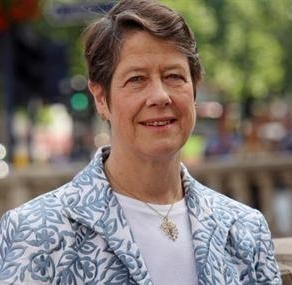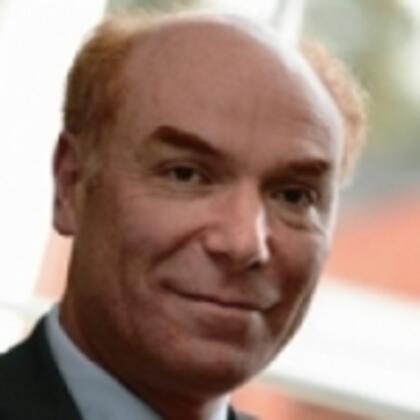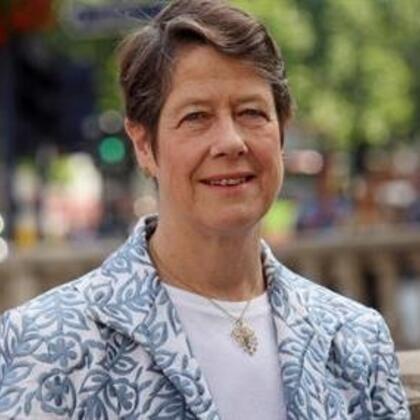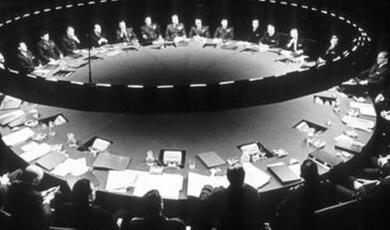Britain Needs an Ivy League
Share
- Details
- Transcript
- Audio
- Downloads
- Extra Reading
Professor Kealey argues the case for world-class universities being established in the UK as charitable bodies independent of the state for teaching, alongside the benefits of access to state funding for research.
The lecture is delivered by Professor Terence Kealey, Vice-Chancellor, Buckingham University, with a response by Professor Malcolm Gillies, Vice-Chancellor, London Metropolitan University. The event is chaired by Dame Judith Mayhew Jonas.
Download Transcript
17 October 2012
Britain Needs an Ivy League
Professor Terence Kealey
The Ivy League started with an argument. The professor of theology at Dartmouth College also acted as pastor of the local First Congregational Church, but in 1805 the College and Church fell out over whom to appoint. Ten years later the dispute had still not been resolved, so in 1815 the government of New Hampshire – arguing that as it was largely funding the College it should therefore direct it - threw out the trustees and the College president, installed its own, and nationalised the institution.
But the original trustees sued, and in 1819 the US Supreme Court found for them, judging that the state could not nationalise an independent corporation. The College thus retained its autonomy, with a Charter (originally a Royal Charter) that enjoyed the status of a contract, whose sanctity was to be respected.
The ruling was a landmark because it protected the independence of all private American universities. Not that most people cared: most people supposed Dartmouth would soon go bust.
North America had seen nine Colonial Colleges created before independence in 1776: Harvard (originally known as New College) in 1636; the College of William & Mary 1693; Yale in 1701 (renamed as such in 1718); Princeton (initially as the College of New Jersey) in 1746; Pennsylvania (the College of Philadelphia) in 1751, Columbia (King’s College) in 1754; Brown (Rhode Island College) in 1764; Rutgers (Queen’s College) in1766; and Dartmouth 1769.
The institutions were founded by clergymen as theological academies, with governance structures modelled on the colleges of Oxford and Cambridge. So the governing body or Corporation at Harvard, for example, comprised the President and Fellows, they being either College academics or local clergymen who helped the College. To this day, in recapitulation of its Oxbridge roots, the President of Harvard chairs the Corporation, and though the other trustees are now non-executive, they retain the title of Fellows.
By 1776, the institutions of what is today known as the Ivy League had already embraced their own governance revolution when many of the academics on its governing bodies were replaced by politicians. In colonial days Church and State were not separated, so governments readily funded the largely-theological colleges, so American universities were then largely like the mass of British universities today: private charities that had surrendered some autonomy for government money. And the loss of autonomy was real: at Yale, for example, Connecticut’s Governor, Deputy Governor and six state senators sat on the governing body, and largely ran it.
But following the separation of Church and State after 1776, the Ivy League embarked on its second governance revolution: during the 19th century it ejected the politicians, replacing them on its councils with private donors. Why? Because the politicians withheld their money. Whenever a dispute arose with the local university – and such disputes were perennial because the universities had learned to defend their rights – the politicians stopped giving public money to a private body. Consequently, the universities soon found themselves in financial difficulties.
But to everybody’s surprise, including their own, seven of the Colonial Colleges survived by alumni-giving and fee income, and are now known (together with Cornell which, though founded in 1865, was admitted to what is, formally, a regional sports league, officially established only in 1954) as the Ivy League. Only William & Mary and Rutgers resorted to state-ownership.
Most universities in the world today are state universities, and since higher education and scholarship are conventionally described as public goods that require government money, economic theory predicts that independent universities should languish at the bottom of the three major international university league tables. Yet the converse is true.
The Shanghai Jiao Tong Ranking is based primarily on measurements of science (numbers of papers in top journals, numbers of citations, numbers of Nobel laureates on the staff). Quacquarelli Symonds is based primarily on reputation (banks of academics – and also of industrial employers - are asked their opinion of a range of universities, though some 5 other indices including the proportion of international students and staff are also integrated into the final score). The Times Higher survey methodology is a mixture of the other two in that it is based primarily on research output (65 per cent of the final score) but it integrates a total of 13 different indicators in its final score including research and industrial income, staff student ratios and teaching reputation.
Currently Shanghai places Harvard first, Stanford second, MIT third, Berkeley fourth and Cambridge fifth; Quacquarelli Symonds gives us MIT 1st, Cambridge 2nd, Harvard 3rd, UCL 4th and Oxford 5th. And the Times Higher calls Caltech first, Oxford and Stanford joint second, Harvard fourth and MIT fifth. Those tables employ different methodologies, yet they produce similar, credible, rankings.
Of the first 20 universities in their tables, moreover, Shanghai lists only four state universities (all American) and only one non-anglophonic one (Tokyo), the Times Higher also lists only five state universities including one non-anglophone (ETH Zurich), while Quacquarelli Symonds lists only four state universities including one non-anglophone (ETH Zurich.) Broadly, most of the top 100 universities globally are anglophonic and/or independent.
Sherlock Holmes noted the curious incident of the dog that did nothing in the night time. That dog here is France. And Germany. And the rest of Europe. A great determinant of university excellence must be GDP per capita – rich countries would have good universities – yet though Europe’s wealth is comparable with the US’s, its universities trail in the global league tables. Why? It may be partly because institutions such as the French Grandes Ecoles do not fit well into the tables, but it is largely because there is a second determinant of university excellence – autonomy.
The great division globally is between universities that speak English (basically, good) and those that do not (basically, not so good). That is not just because bibliometric measures favour the anglosphere, it is also because England’s universities experienced their own, seminal, Dartmouth College Case-like episode, in 1687/8.
In those years James II expelled the President and twenty five fellows of Magdalen College Oxford, to replace them with Catholics. Protestants were outraged (the future Mary II of England, the wife of William of Orange, the Protestant Stadtholder in the Netherlands, sent the fellows £200) and the episode helped precipitate the Glorious Revolution. That in turn spawned the Bill of Rights of 1689, whose 3rd article stated:- “That the commission for erecting the late Court of Commissioners for Ecclesiastical Causes, and all other commissions and courts of like nature, are illegal and pernicious” which, translated, meant that England had a Reformation that in 1689 recognised the ancient rights of its universities to independence.
Europe’s universities were born independent. The first, Bologna, was founded around 1100 by students seeking an education in law. Then Padua and Montpellier were founded, also as student initiatives, educating in medicine and the sciences. Those Mediterranean universities were democratic, being run by the students. Soon afterwards the northern universities of Paris, Oxford and Cambridge were created, by scholars, and they too were democratic, being run by the masters. But soon thereafter universities were created by the Church (often from pre-existing cathedral schools) or by monarchs, and those were not so democratic: the key appointment – that of the leader (aka vice-chancellor, rector or president) – often being in the gift of the Church or crown.
Worse, the Church then took control of the erstwhile independent, democratic, universities. As Pope Boniface VIII stated in 1294:- “You Paris masters think that the world should be ruled by your reasonings but it is to us, not you, that the world is entrusted” and the authorities thus forced the oversight of the Church onto the universities, which is why many academic titles such as Dean or Doctor are ecclesiastical. Subsequently, under inquisitions, absolutism and Napoleon, continental Europe fettered its universities, generally nationalising them. But after 1689 England’s took an independent course.
The trajectory of continental Europe’s universities can be described thus: initially they were created by the students or staff as guilds, such institutions being commonplace at the time. Guilds were associations of tradesmen, following the same trade, that (i) were recognised by the local authorities and (ii) were representative (if not fully democratic by contemporary standards) in their government. But the universities soon sought the protection of sovereigns against the local authorities and against the town guilds because the universities had universal interests (hence ‘university’) such as recruiting students globally (which local people rarely appreciated.) Equally sovereigns (whether holy roman emperors or popes) needed universities to provide legal, theological and diplomatic opinions to support them in their incessant conflicts, so the sovereigns supported the universities in the face of their local communities, providing them with legal privileges.
But once buttressed by sovereigns in their privileges (such as access to special law courts) the universities soon found that they were dependent on those sovereigns for the maintenance of those privileges. Only after the rule of law had been introduced (after 1689 in the anglosphere) could universities be secure in their ancient privileges. But the rule of law was introduced on the continent of Europe generally only after the universities had been nationalised and had lost their privileges.
England’s – later Britain’s – universities did not spin out of 1689 fully independent. During the 18th century monarchs, politicians and bishops interfered relentlessly. So for example, as DA Winstanley reported in his University of Cambridge in the Eighteenth Century (1922) the practice of conferring degrees by royal mandate (ie on the royal prerogative) remained an abuse in the 18th century, especially under the Duke of Newcastle in the 1760s. But the universities were on an independent trajectory and by 1914 they were as independent as today’s Ivy League. They were also very good.
It is often claimed that the revival of Oxford and Cambridge during the 19th century was attributable to government-stimulated reforms, but it was the government that had initially plunged Oxbridge into mediocrity when it subjected it to the Church (most dons were obliged to be unmarried priests of the Church of England until as late as 1877.) The real source of Oxbridge’s revival, though, was of course competition, and when the new independent civic universities appeared (UCL and KCL in London being the first to appear, in the late 1820s/early 1830s) then Oxbridge sought to emulate them.
But just as the British independent universities were doing so well, the Great War bankrupted them: their fee income disappeared as the young men joined the army, and their endowment income collapsed under the wartime inflation. So in 1919 the government’s University Grant Committee was instituted with, initially, an annual budget of £1 million; but various government agencies were soon funding the bulk of the universities’ income, and with that funding came increasing central control.
The universities of Britain’s dominions inherited the legal independence of 1689 but in various ways they came to similar settlements as Britain’s: they, too, accepted government money in exchange for losses of autonomy. The US’s course, though, has been more diverse, and it has some five types of university, namely (i) the Ivy League and similarly independent research universities including MIT, Stanford and Chicago, (ii) the independent liberal arts colleges, (iii) state universities, (iv) state community colleges, and (v) for-profit institutions.
We thus have an experiment between different types of university, and the global league tables show that – overlooking outliers - the American independent research universities are collectively the best in the world; the Anglophonic legally-independent-but-financially-dependent universities such as Oxford, Cambridge and UCL come next; the state universities come after them; and the rest come nowhere (though the tables are research-orientated, to the disadvantage of [i] the liberal arts colleges, which teach superbly, and of [ii] the community colleges, which widen access. The for-profits rarely do well in any category.)
Why is autonomy an independent variable for university excellence? One answer is monopoly: when a government has nationalised the universities and – as generally happens – has abolished fees, then that government enjoys a monopolistic control of higher education. Why, therefore, would it put into the universities a penny more than the absolute minimum? Yet the consequences are, as the EU Commission reported in its 2003 Role of the Universities in the Europe of Knowledge that:-“American universities have far more substantial means than those of European universities – on average, two to five times higher per student … The gap stems primarily from the low level of private funding of higher education in Europe”. Since one source of university excellence is money, free-market America beats monopolistic Europe because students and their parents will contribute more in fees than will governments.
Competition is another source of excellence and, when students pay, independent universities compete to satisfy them where state universities need not. Equally, in their search for reputation, independent universities compete for research monies in ways state universities need not. And independent universities are more likely than apparatchiks in some distant capital to know how they should be run. The endowments of the American independent universities, moreover (Harvard $31.7 billion; Yale $19.3bn; Princeton $17bn; Stanford $16.5bn, etc) show how public goods can attract private philanthropy, which in turn supplies social justice: the League operates ‘needs blind admissions’, so no one is refused entry if they can’t pay.
Competition, moreover, spills over: higher education in America is benchmarked by the Ivy League, so one reason its state universities are unusually good is that they are forced to compete, not only against each other (there are effectively 50 competing state systems in the US) but also with the League, which is why some state universities have accumulated startling endowments (Texas $17 billion; Michigan $7.8bn; Texas A&M $7bn; California $6.3bn; Virginia $4.7bn, etc.)
And then there’s academic freedom. In his 2008 book Academic Freedom in the Wired World Robert O’Neil, the former president of the University of Virginia, reported how a politician, on disagreeing with Professor Rodney Smolla of the state-owned College of William & Mary, threatened him with:- “Your institution will pay for this” to which Smolla replied with:- “I’ve just moved to the [independent] University of Richmond.” It is no coincidence that many of the challenging thinkers of our time, from Milton Friedman (Chicago) on the right to Noam Chomsky (MIT) on the left, have been based in independent universities.
Autonomy fosters academic excellence in one other way: academic governance. The myth is that academics are otherworldly inhabitants of ivory towers who need help from governments or from lay external non-executive trustees in the simplest of tasks. But the empirical evidence establishes the opposite, namely that the best universities in the world are the ones where the academics have the greatest say in their management. Thus Oxford and Cambridge are run by the academics themselves, and though the Ivy League is run by councils of trustees, the President of the university is often the executive chairman of the council and, in any case, the Ivy League is marinated in a culture of academic autonomy.
The culture of less good universities is more generally one where academics are marginalised by lay external non-executive trustees. The history of Gresham College illustrates the dangers of trustee power in that it was founded in 1597 with a significant endowment yet it failed to challenge Oxford and Cambridge. In their 1997 bookA Brief History of Gresham College 1597-1997 Richard Chartres (the Bishop of London) and David Vermont (the Chairman of Council of Gresham College) attributed Gresham’s relative failure to perennial conflict between the Council and the academics. Had Gresham been run solely by academics, it is not unreasonable to suppose that like their peers in Oxbridge (and the early Gresham scholars were all from Oxbridge) they would have risen to the challenge of self governance.
The secret of good university government, therefore, is a group of trustees who empower, not disempower, academic autonomy, and that is more likely to be achieved when Government, too, is not seeking to disempower the academics.
An Ivy League university is independent in its undergraduate teaching, with none of the caps on fees or numbers - nor any of the subjections to agencies such as OFFA - that shackle our own. But it has competitive access to government research funding.
Ever since Mrs Thatcher’s introduction in 1980 of fees for foreign students, Britain’s universities have grown ever more independent (witness their ever-improving performance in the global league tables) so let us finalise that liberalisation and create our own Ivy League. How? The leading universities should be free to cherry-pick HEFCE’s QR money - and that alone - because it is their access to HEFCE’s teaching money that shackles the universities with caps and OFFA. The universities should thus be freed to charge the fees the market will bear and to expand or contract at will, while still accessing HEFCE’s research money Ivy League-style.
In its Education at a Glance 2012 the OECD found that England’s tuition fees had produced the world’s most “advanced” support for students - without damaging social justice. If we completed our liberalisation and made the creation of a British Ivy League a national goal, we could dominate the global league tables as we now garner Olympic medals.
Do league tables matter? It could be argued that they are irrelevant or even misleading, but inasmuch as they stimulate competition then they must also stimulate excellence. Further, they encourage the recruitment of international students. So Universities UK’s 2009 Impact of Universities on the UK Economy 4th report showed that British higher education earned £5 billion from international (non EU) students every year, which is a significant boost to the British economy.
League table dominance, moreover, helps project soft power, and in a sincere form of flattery the French, Germans and other continental countries are beginning to copy the anglospheric model in an attempt to improve their own national league table positions.
It is possible that league tables distort, or ignore the strengths of different non-anglosphere models, but the fact that continental Europe is shifting to the anglosphere model rather than the other way round suggests that league table success matters. And the logical conclusion of the Anglosphere model is the Ivy League.
© Professor Terence Kealey 2012
This event was on Wed, 17 Oct 2012
Support Gresham
Gresham College has offered an outstanding education to the public free of charge for over 400 years. Today, Gresham plays an important role in fostering a love of learning and a greater understanding of ourselves and the world around us. Your donation will help to widen our reach and to broaden our audience, allowing more people to benefit from a high-quality education from some of the brightest minds.


 Login
Login











